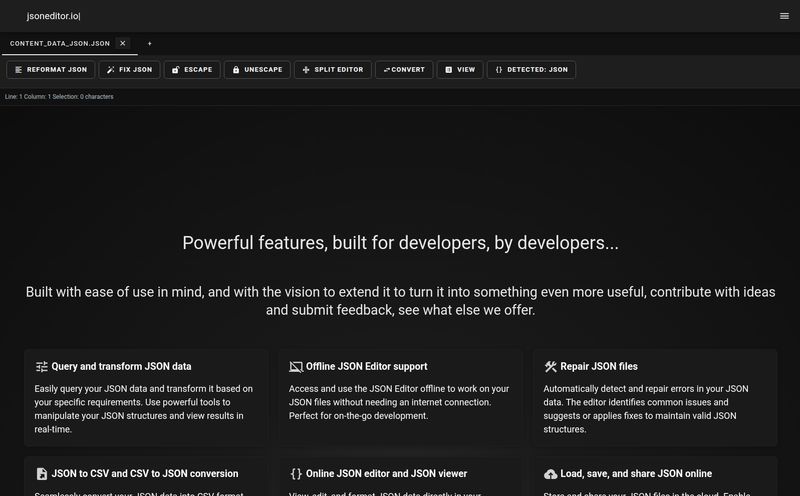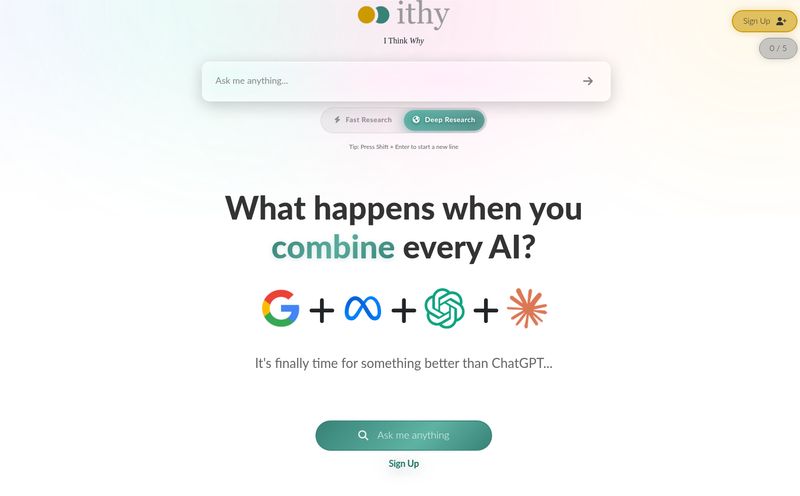You've been there. I've definitely been there. You get assigned a new project, or you stumble upon a cool open-source library, and you click that link to its GitHub repository. And then... your heart sinks just a little. It's a sprawling digital city of folders, sub-folders, and cryptic file names. Where do you even begin? You could spend the next three days just trying to figure out where the main configuration file is. It’s a rite of passage for every developer, but man, it can be a drag.
For years, we've just accepted this as part of the job. But with the AI boom, a new class of tools is popping up, promising to be our friendly guide, our digital sherpa through these code mountains. One name that floated across my desk recently was GPTDuck. The premise is simple, almost deceptively so: let an AI read the repository for you, and then just... ask it questions. Sounds like a dream, right?
But like any dream, you have to wonder when you'll wake up. The story of GPTDuck is a bit more interesting than your average tool review. So grab a coffee, and let's get into it.
So, What Was GPTDuck Supposed to Be?
At its core, GPTDuck was designed to be a lifesaver for anyone who needs to get up to speed on a codebase—and fast. The idea is that you feed it a link to a public GitHub repository. From there, the tool gets to work. It downloads the entire repo, scans every line of code, and then creates something called 'code embeddings'.
Think of it like this: instead of just having a dumb search function that looks for keywords, GPTDuck was meant to build a contextual 'brain' for the entire project. It understands the relationships between different functions, how variables are passed around, and what different parts of the code are trying to accomplish. It’s less of a search engine and more of a junior developer who has already spent a week studying the code and is ready to answer your questions.

Visit GPTDuck
The Magic Behind the Curtain: How It's Meant to Work
The process, from what I've gathered, is pretty straightforward on the user's end. It's the classic three-step dance of modern AI tools:
- You provide the URL. Just find a public repository on GitHub you're curious about and hand over the link. Simple enough.
- It builds the brain. This is the embedding part. The tool churns through the code, creating a semantic index. This isn't instant, of course. A bigger project would naturally take more time to process and 'understand'.
- You ask your questions. Once the indexing is done, you get a chat-like interface. You can ask things like,
Where is the database connection handled?
orWhich function is responsible for user authentication?
or evenExplain this chunk of code in `main.py` like I'm five.
The potential here is huge. For a junior dev trying to contribute to a huge open-source project like React, this could be incredible. For a senior dev doing a quick code review, it could save hours of manual searching. For me, it would mean no more `Ctrl+F`ing my way through 50 files to trace a single variable. A real game-changer.
The Big 'Buts': Understanding GPTDuck's Limitations
Now, no tool is perfect, and from the get-go, GPTDuck had some clear guardrails. These aren't necessarily flaws, but practical limitations you'd need to be aware of. It's not a magic wand that works on everything.
First off, it was designed for public repositories only. That makes perfect sense from a security and privacy standpoint. You can't just point an external tool at your company's top-secret, proprietary codebase. So, this was always going to be a tool for open-source exploration, not internal enterprise audits.
Then there were the size constraints. The documentation I saw mentioned a cap of less than 100MB and fewer than 200 files. This is a pretty significant restriction. While it covers a lot of smaller libraries and personal projects, it rules out many of the massive, complex monorepos that you'd arguably need the most help with. It suggests the tool was either in an early stage, or targeting a specific niche of smaller-to-medium projects.
Finally, there's the indexing time. It's a necessary evil. Building those fancy code embeddings takes computational power. Depending on the server load and the size of the repository (even within the limits), you might have to wait a bit. It’s not a knock, just a reality of how this tech works.
The Elephant in the Room: Where on Earth is GPTDuck?
So, I've been talking about this tool and its potential. I was genuinely excited to try it out. I pictured myself dropping in a few of my favorite obscure repos from my GitHub starred list. And then I went to the website, gptduck.com.
And I was greeted by... a Namecheap parked domain page. Whoops.
This is the part of the story where things get a bit mysterious and, frankly, very typical of the startup world. A tool with a great concept, some buzz, and then... radio silence. The website's current state tells us a lot. It means the domain registration is active, but there's no live service pointed to it. What happened?
My educated guess? It could be one of several things:
- A Weekend Project: It might have been a brilliant side project or a hackathon submission that the creator never had the time or resources to fully develop and maintain.
- An Acquisition or Pivot: Sometimes, a small team builds a cool piece of tech that gets quietly bought by a bigger company and integrated into their own product. The original brand just fades away.
- It Just... Failed: Let's be real. The tech world is brutal. Maybe the server costs were too high, the user adoption wasn't there, or the developer just moved on to other things. It happens. A lot.
Whatever the reason, as of right now, GPTDuck seems to be a ghost. A fascinating idea that isn't currently available for use. It's a bummer, for sure. I was ready to have my workflow changed.
Are There Any Good Alternatives to This Ghost?
Yes! Thankfully, the idea behind GPTDuck is so good that other, better-funded players are deep in this space. If you're bummed that you can't use GPTDuck, don't be. You have some seriously powerful options that are very much alive and kicking.
One of the biggest names is GitHub Copilot Chat. It's built right into the GitHub ecosystem and is available in IDEs like VS Code. It's incredibly powerful because it's from the source. It can answer questions about your code, explain things, and even write new code for you. It's probably the closest and most robust alternative.
Another fantastic tool I've been playing with is Sourcegraph Cody. Sourcegraph has been a monster in the code search and intelligence space for years, and Cody is their AI assistant. It has a deep understanding of codebases and is built for both open-source and private, enterprise-level code. It does a lot of what GPTDuck promised, but on a much grander scale.
So while GPTDuck the product may have vanished, its spirit lives on in these more mature platforms.
Final Thoughts on a Great Idea
So, what's the verdict on GPTDuck? Well, you can't really review a product that doesn't exist. But you can absolutely review an idea. And the idea behind GPTDuck is a 10/10. The need to rapidly understand complex codebases isn't going away. In fact, it's only getting more critical as software eats the world.
GPTDuck serves as a perfect snapshot of a moment in the AI gold rush—a brilliant concept that, for whatever reason, didn't cross the finish line. It's a reminder that a great idea is only the first step. Execution, funding, and a little bit of luck are what turn a parked domain into a powerhouse tool. While I'm sad I can't ask GPTDuck any questions, I'm excited about the path it helped illuminate. Now, if you'll excuse me, I'm off to ask GitHub Copilot why my CSS is broken again.
Frequently Asked Questions about GPTDuck
What was GPTDuck supposed to do?
GPTDuck was a tool designed to help users understand GitHub repositories. You would provide a link to a public repo, and the tool would index the code and allow you to ask natural language questions about it, like "How does the user login work?" or "What does this function do?"
Can I still use GPTDuck?
Unfortunately, no. As of late 2023 and into 2024, the official website for GPTDuck (gptduck.com) is a parked domain page, indicating the service is not currently active or available to the public.
What are code embeddings?
In simple terms, code embeddings are a way of converting code into a numerical representation that an AI can understand. This process captures the semantic meaning and context of the code, not just the keywords, allowing the AI to understand relationships between different parts of a program and answer complex questions about it.
Are there good alternatives to GPTDuck?
Yes, absolutely. The most popular and well-supported alternatives include GitHub Copilot Chat, which is integrated directly into many code editors, and Sourcegraph Cody, which is a powerful AI code assistant built for both individual and enterprise use.
Why is the GPTDuck website just a parked page?
While there's no official statement, it's common for tech projects to be discontinued. Reasons could range from the project being a personal experiment that was never fully launched, to the developer moving on to other things, or a lack of funding to maintain the servers.
Was GPTDuck a free tool?
Information on pricing was never officially released or was very scarce, likely because the tool never reached a full public launch. Given the computational costs of AI processing, it likely would have adopted a freemium or subscription model similar to other AI developer tools on the market.
References and Sources
- The former home of the project, now a parked domain: http://gptduck.com/
- GitHub Copilot: https://github.com/features/copilot
- Sourcegraph Cody: https://sourcegraph.com/cody



